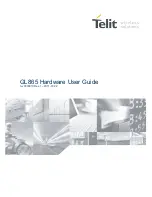
A-9
80C186 INSTRUCTION SET ADDITIONS AND EXTENSIONS
A.2.2 Arithmetic Instructions
IMUL destination, source, data
IMUL (integer immediate multiply, signed) allows a value to be multiplied by an immediate op-
erand. IMUL requires three operands. The first, destination, is the register where the result will
be placed. The second, source, is the effective address of the multiplier. The source may be the
same register as the destination, another register or a memory location. The third, data, is an im-
mediate value used as the multiplicand. The data operand may be a byte or word. If data is a byte,
it is sign extended to 16 bits. Only the lower 16 bits of the result are saved. The result must be
placed in a general-purpose register.
A.2.3 Bit Manipulation Instructions
This section describes the eight enhanced bit-manipulation instructions.
A.2.3.1 Shift Instructions
SAL destination, count
SAL (immediate shift arithmetic left) shifts the destination operand left by an immediate value.
SAL has two operands. The first, destination, is the effective address to be shifted. The second,
count, is an immediate byte value representing the number of shifts to be made. The CPU will
AND count with 1FH before shifting, to allow no more than 32 shifts. Zeros shift in on the right.
SHL destination, count
SHL (immediate shift logical left) is physically the same instruction as SAL (immediate shift
arithmetic left).
SAR destination, count
SAR (immediate shift arithmetic right) shifts the destination operand right by an immediate val-
ue. SAL has two operands. The first, destination, is the effective address to be shifted. The sec-
ond, count, is an immediate byte value representing the number of shifts to be made. The CPU
will AND count with 1FH before shifting, to allow no more than 32 shifts. The value of the orig-
inal sign bit shifts into the most-significant bit to preserve the initial sign.
SHR destination, count
SHR (immediate shift logical right) is physically the same instruction as SAR (immediate shift
arithmetic right).
Summary of Contents for 80C186EA
Page 1: ...80C186EA 80C188EA Microprocessor User s Manual...
Page 2: ...80C186EA 80C188EA Microprocessor User s Manual 1995...
Page 19: ......
Page 20: ...1 Introduction...
Page 21: ......
Page 28: ...2 Overview of the 80C186 Family Architecture...
Page 29: ......
Page 79: ......
Page 80: ...3 Bus Interface Unit...
Page 81: ......
Page 129: ......
Page 130: ...4 Peripheral Control Block...
Page 131: ......
Page 139: ......
Page 140: ...5 ClockGenerationand Power Management...
Page 141: ......
Page 165: ......
Page 166: ...6 Chip Select Unit...
Page 167: ......
Page 190: ...7 Refresh Control Unit...
Page 191: ......
Page 205: ......
Page 206: ...8 Interrupt Control Unit...
Page 207: ......
Page 239: ...INTERRUPT CONTROL UNIT 8 32...
Page 240: ...9 Timer Counter Unit...
Page 241: ......
Page 265: ......
Page 266: ...10 Direct Memory Access Unit...
Page 267: ......
Page 295: ...DIRECT MEMORY ACCESS UNIT 10 28...
Page 296: ...11 Math Coprocessing...
Page 297: ......
Page 314: ...12 ONCE Mode...
Page 315: ......
Page 318: ...A 80C186 Instruction Set Additions and Extensions...
Page 319: ......
Page 330: ...B Input Synchronization...
Page 331: ......
Page 334: ...C Instruction Set Descriptions...
Page 335: ......
Page 383: ...INSTRUCTION SET DESCRIPTIONS C 48...
Page 384: ...D Instruction Set Opcodes and Clock Cycles...
Page 385: ......
Page 408: ...Index...
Page 409: ......















































